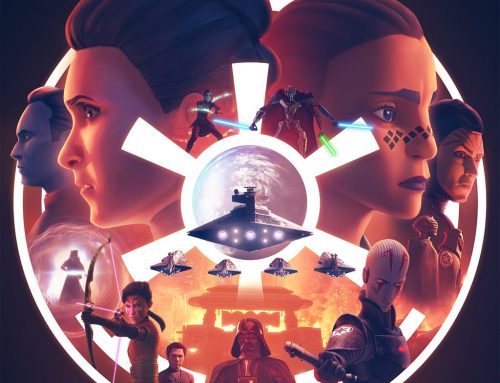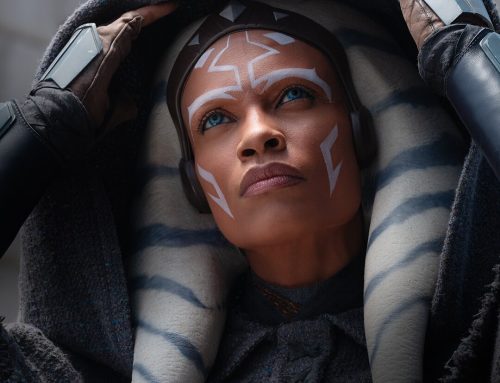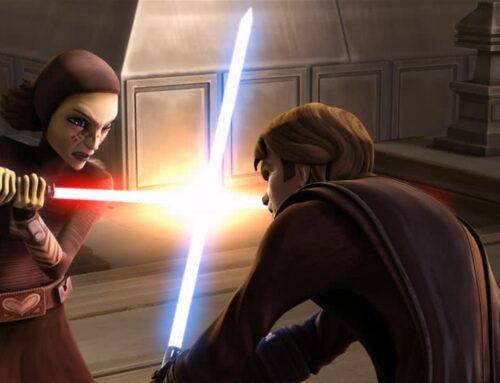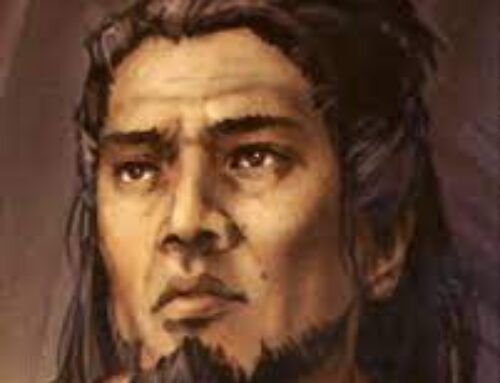Count Dooku: A Movie Villain Who Dominated the Small Screen
I’ve come to accept the Prequel Trilogy as a valid part of the Star Wars universe, but mainly because of the amazing story-telling that grew out of it in Star Wars TV shows like Clone Wars, Rebels and The Mandalorian. Take, for example, Jedi Master Count Dooku, also known as Sith Apprentice Darth Tyranus – he’s a fairly flat character in the movies, but he’s brought to life in all his villainous glory on the small screen.
Count Dooku at the movies
Count Dooku is introduced in Star Wars Episode II: Attack of the Clones as a former Jedi master somehow gone rogue and causing trouble in the galaxy. Young Jedi Obi-Wan Kenobi, following a trail of clues that takes him first to Kamino and then to Geonosis, eventually comes face to face with Dooku. Dooku is revealed to be plotting against the Republic, and he shows his sinister side by offering up Obi-Wan, Anakin Skywalker and Padme Amidala for some bloodsport games to curry favor with the various leaders of the fledgling Separatist movement.
Everything falls to chaos when the rest of the Jedi arrive, our heroes are rescued and the new clone troopers face off against the droid army. Dooku flees but is chased down by our two Jedi heroes, Anakin and Obi-Wan, and we finally see Dooku not as a wayward Jedi but as a menacing Sith lord.

Not even Christopher Lee could save Attack of the Clones
Dooku is played with icy majesty by veteran actor Christopher Lee, but like so many fine actors in the Prequel Trilogy, he isn’t given much quality writing to work with, and Dooku’s scenes don’t carry as much impact as they should.
Take the climactic scene of Attack of the Clones, for example, which starts with lightsaber combat pitting Dooku versus Obi-Wan and Anakin. We know by now that Obi-Wan and Anakin are both excellent swordsmen, but the speed with which they’re dispatched is shocking – with Anakin losing his arm in the brief fight. Then we enjoy the dual surprise of Master Yoda completely crushing it with a lightsaber and the fact that Dooku is, in fact, Yoda’s former Padawan apprentice.
But it all sadly fell kind of flat, and when Dooku fled we didn’t really know what to think. Attack of the Clones ends with Dooku reporting back to his Sith master, Darth Sidious, and we finally hear Dooku’s Sith name: Darth Tyranus.
Revenge of the Sith was almost a relief
We see Dooku/ Tyranus again in the first act of Revenge of the Sith, where he once again faces off against Kenobi and Skywalker after his daring mission to kidnap Supreme Chancellor Palpatine. But this time, Anakin bests Dooku, slicing off his hands and, after a quick prompt from Palpatine, his head. Dooku’s story comes to an abrupt end, and Star Wars moves on with the fall of Anakin Skywalker.
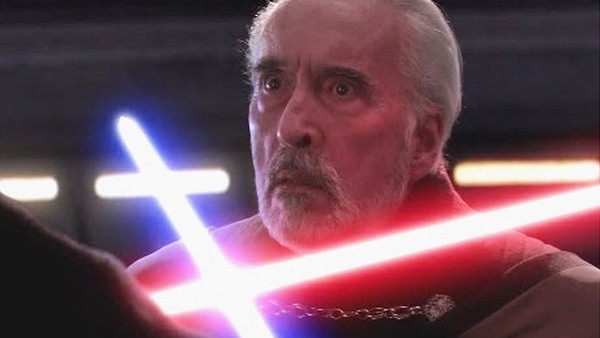
And seeing the end of Dooku was, frankly, kind of a relief. With all respect to Christopher Lee, the character in the movies never really came alive as a truly frightening or dangerous villain. Yes, Dooku watched with cold anticipation as our heroes were thrown to the monsters on Geonosis; yes he hired bounty hunter Jango Fett to kill Senator Amidala; and yes he was clearly a grand master swordsman with Force lightning at his command. But since the movies only covered the very opening and the very closing of the clone wars, we never got to see Dooku as the central figure in the galactic drama that he clearly was supposed to be. He was just a prop – an obstacle for our heroes to overcome in their broader story.
If all we had was the movies, Count Dooku would be a fairly forgettable figure.
Count Dooku during the Clone Wars
Thankfully, though, we have far more than just the movies. Across one feature film and seven glorious seasons, Star Wars: The Clone Wars brought this period of Star Wars history to life – and a big part of that was the reinvention of Count Dooku as a powerful, cunning and truly evil character.
The visible Sith Lord
As the war began, the Jedi Council was fully aware of Dooku’s status as a Sith lord, and they drew the obvious conclusion that he wanted to destroy the Galactic Republic as part of a Sith plan to rule the galaxy. With the Dark Side clouding their vision, the Jedi Order threw everything they had against Dooku.
As an aside, I used to wonder why the Jedi Order waded so quickly into the war. Having served as peacekeepers for hundreds of years, why did they not follow the example of Duchess Satine Kryze of Mandalore and declare themselves neutral? Few Jedi held any illusions about the Republic actually being a noble institution worth saving, and I can hardly see Yoda and the Jedi Council agreeing to participate in the deaths of millions of living beings with an excuse like, “Well, the Republic is totally corrupt and ineffective, but better the devil you know, right?”
But… Since the Jedi Order knew from the very start of the clone wars that Count Dooku was the Separatist leader, it was an easy leap to make that the entire Separatist Alliance must also be evil. After all, hadn’t Jedi Sifo Dyas ordered the creation of the clone army based on Force visions?
So with Count Dooku leading the Separatists, the war seemed just and seemed to fit within the Jedi Code – and so the Jedi took sides and went to war. And in so doing, played right into the hands of Darth Sidious.
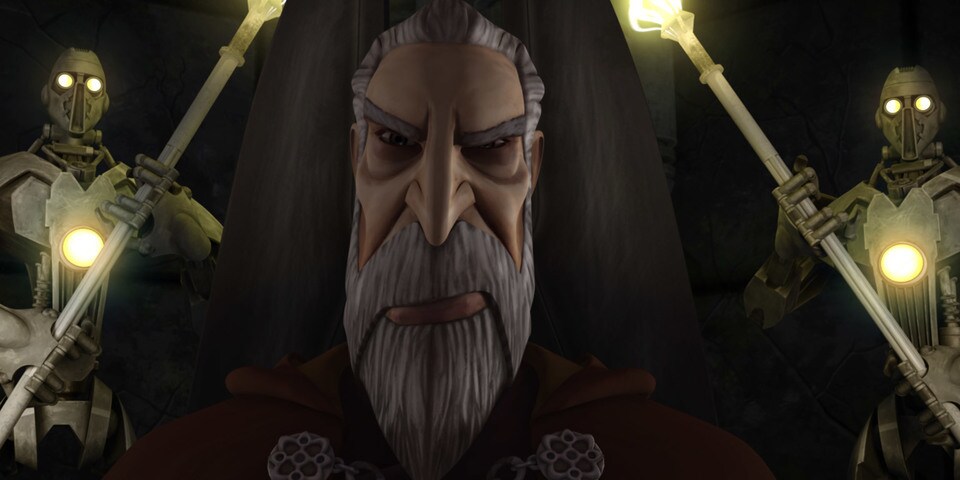
Source
Second only to Darth Sidious
As was his plan for so long, Darth Sidious remained hidden from view, continuing to play his role as Chancellor Palpatine leading the Republic while Dooku commanded the Separatists. Count Dooku appeared publicly as a figure of great power, but whenever the two Sith lords interacted there was no question of who was in charge. Sidious ruled with an iron fist and Tyranus obeyed.
Although the resentment was clear on Dooku’s lowered face, and throughout the animated series we got to see his raw ambition and rage bubbling upward. We could tell that it was only a matter of time before Dooku tired of being second place and made a play for total domination.
Count Dooku and the Rule of Two
The nature of Sith power has always been unstable, as every single Sith lord seeks ultimate power. After a devastating civil war that decimated the Sith ranks – a thousand years before the last days of the Galactic Republic – the infamous Darth Bane instituted the Rule of Two: only two Sith lords would there ever be, a master and an apprentice. The master would rule for as long as they could maintain power, and the apprentice would serve for as long as they lacked the strength to kill their master.
The Rule of Two worked for a millennium as the Sith remained in the shadows, researched their powers, and waited for the opportunity. The system was effective in its cruel simplicity, but Dooku, like any good Sith apprentice, very quickly began to subvert it.
Dooku and Asajj Ventress
As Clone Wars began, we learned that Darth Tyranus already had an apprentice, Asajj Ventress of Dathomir. Immediately we saw in Ventress another dangerous foe, a powerful Force-wielder who was easily a match in lightsaber combat for Obi-Wan Kenobi and most other Jedi. She became a frequent antagonist in the early episodes of the show, willing to Force-choke, slash or skewer anyone who stood in her way.
Described initially as merely an assassin, Asajj Ventress was clearly being groomed as Dooku’s new Sith apprentice. He was building his power, both politically and with the Force, and he undoubtedly planned to challenge Sidious with Ventress at his side when the time was right.
But beneath his kindly facade, Sidious was a truly menacing Sith lord and he saw through Dooku’s deception. With chilling finality he ordered Dooku to kill Ventress as a show of loyalty – and Dooku obeyed without question. Here is where we see the evil, self-serving nature of the Sith, with Tyranus discarding Ventress – a person into whom he’d committed years of training and support – as nothing more than a tool. His betrayal of her was swift and absolute, and it started Asajj Ventress down the path toward one of the most interesting, complex and sympathetic character arcs in all of Star Wars.
One of the best Star Wars novels, Dark Disciple, explores this relationship further, when Jedi Quinlan Vos teams up with Ventress to attempt yet another assassination of Dooku. The attempt fails, of course, and Vos is temporarily turned to the Dark Side. Through his long relationship with Ventress, Darth Tyranus displays some of his most awesome power.
Dooku and Savage Opress
Ventress returned home to Dathomir where she conspired with the Nightsisters to kill Dooku. At first she and her sisters moved directly, confronted Dooku in his stronghold and nearly succeeded. But this master of the Dark Side was just too powerful and Ventress barely escaped with her life. She returned to Dathomir and helped create a subtler plan – to bring betrayal upon Dooku from within.
Savage Opress is one of the most tragic figures in Star Wars, but his story arc is some of the best story telling in all of Clone Wars. Presented to Dooku by Mother Talzin as a gift, Savage served initially as a new apprentice. We glimpsed Dooku’s training techniques – instruction backed up by Sith lightning – and watched as Savage Opress was twisted into a creature of darkness. Powerful in the Force, he embraced the Dark Side and served his new master well, quickly drawing the attention of the Jedi Order. But his secret role as an agent of the Nightsisters never wavers, and fans were treated to a three-way Sith battle as Opress and Ventress attack their former master.

Source
Dooku and General Grievous
Dooku survived the assassination attempt and his retribution was devastating. He ordered General Grievous and an entire Separatist army to invade Dathomir and wipe out the Nightsisters. The attack is devastatingly successful and cements our impression of Count Dooku as a villain.
But his relationship with General Grievous is worth noting. Although not a Sith apprentice per se, Grievous obviously received lightsaber training from Dooku: there were too many Jedi lost to Grievous’s blades to imagine anyone else training him.
Dooku’s Jedi past
Because let’s not forget that Dooku was a Jedi master for a very long time, a towering figure in the Order up until just before Attack of the Clones. He was the Padawan to none other than Master Yoda and his Padawan in turn was Qui-Gon Jinn. For decades Dooku was considered one of the very best of the Order, and his sudden departure would certainly have been a shock.
Dooku learned about Sifo Dyas and his Force visions revealing the end of the Republic, and with his knowledge of the Jedi archives he was able to direct Sifo Dyas toward certain Jedi prophecies that seemed to confirm the younger man’s fears. At Dooku’s subtle urging, Sifo Dyas commissioned the creation of a clone army to augment the minimal Republic forces.
This move might have seemed contradictory to the Sith ambitions to control the Galactic Senate, but by this time Dooku knew enough to know that it advanced Sidious’s secret plot. Although Palpatine never revealed to any of his apprentices the full measure of his plan, by making Count Dooku a central figure in the drama he played to the former Jedi’s ego and ambition.
Dooku and Obi-Wan Kenobi
Choosing Dooku, a Jedi master, as his pawn was another way that Palpatine clouded the ability of Yoda and others to see clearly. Even when Dooku was clearly identified as a Separatist sympathizer, Jedi Council member Ki Adi Mundi (in one of his many errors that proves he’s the worst Jedi ever) claimed rather self-righteously that Dooku, as a former master, was incapable of the crimes Obi-Wan was uncovering.
Obi-Wan’s relationship to Dooku didn’t help matters, either, as Dooku was the master of Obi-Wan’s own master, making Dooku – as described in the brilliant novelization of Revenge of the Sith – a sort of spiritual grandfather to Obi-Wan. Dooku allowed this image of him as a gentle retiree to carry on for as long as possible, and it wasn’t until he was forced to draw his lightsaber against Obi-Wan, Anakin and Yoda that his connection to the Dark Side was revealed. Palpatine knew exactly what he was doing, drawing in such an influential Jedi to become his new apprentice.
Count Dooku and Anakin Skywalker
But ultimately Darth Sidious, dark lord of the Sith, was loyal to no-one but himself, and just as he ordered Tyranus to get rid of his apprentice Ventress, Palpatine discarded Dooku when a better tool came along. For just as Dooku was secretly grooming a new apprentice, so was Palpatine.

Source
Dooku, in his arrogance, never saw the threat to his own position that Anakin Skywalker posed, and his one mistake was to ignore the growing power of the young Jedi. Although in the movies alone we see little interaction between Dooku and Anakin, The Clone Wars gives us a rich history of interaction between them. And while Dooku eventually comes to extend Skywalker some basic respect, he never considers this former slave as anything close to his equal. Dooku reminds Anakin of their previous encounters in the opening act of Revenge of the Sith before crossing sabers, supremely confident in his ability to again best this pup – and then pays for his mistake with his life.
Dooku’s one mistake
It’s Sith justice that the man who would shortly become Darth Vader was the very person to murder his predecessor. And it’s poetic justice that Darth Tyranus died because he was blinded by his own arrogance. Star Wars has usually played the good-versus-evil position pretty clearly, but the rise and fall of Count Dooku stands out as an exceptionally satisfying arc.
That is, if you watched Star Wars: The Clone Wars. If all you’ve seen in the movies, Count Dooku is a pretty one-dimensional figure who plays his simple role as a cartoon villain. But with the depth of the story-telling from Clone Wars, he grows into a complex, intriguing, occasionally (almost) sympathetic and all-round dastardly figure who represents a real threat to both our heroes and to the galaxy. His final demise in Revenge of the Sith transforms from a “meh” moment into a dramatic apex that leaves us both shocked and satisfied.
Star Wars is at its very best when viewed in its entirety – movies and TV – and Dooku is one of the best examples of this.
